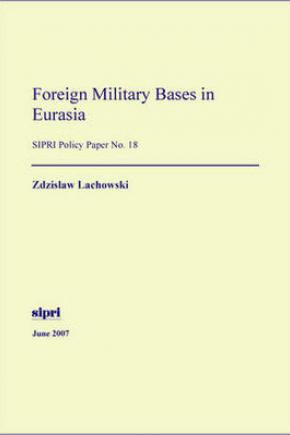Foreign Military Bases in Eurasia
The basing of military forces on foreign territory, at locations leased from or co-occupied with the local authorities (or, rarely, held extraterritorially), is a practice almost as old as warfare itself. Bases can have an economic, political or demonstrative rationale but in all periods their pattern has been linked with the strategic dictates and relationships of the time. Observing changes in the way they are placed, owned and used can provide many clues to the most significant trends of security evolution. This Policy Paper examines what has been happening in basing practices in Eurasia since the end of the cold war.
Up to 1989–90, bases were used by the Soviet Union, the United States and their military alliances in an essentially symmetrical way. Each side clustered its forward bases in the heart of Europe to block and deter the other, while the larger powers competed for extra-European bases that could serve their global mobility or give an edge in regional conflicts. That pattern has been replaced by a less symmetric and possibly transitional situation. In places such as Central Asia, the South Caucasus and the eastern edge of the North Atlantic Treaty Organization (NATO), Russia and the USA are still engaged in a mutual balancing game. More broadly, however, US basing policy has been transformed by the demands of the global campaign against new (including non-state) threats and of operations in Afghanistan and Iraq; while Russia's overall basing pattern has drawn inwards to provide a defensive cordon around its territory and to pin down its remaining allies. Neither great power has found the process simple, and the USA in particular has run into sensitive disputes with friendly host countries as well as suspicions and protests from Russia. US basing has also become a more nationally driven policy, with new examples of NATO's collective use of facilities limited to the new theatres of conflict outside Europe. Emerging powers like China and India are barely starting to join in the basing game but seem likely to have such ambitions in future.
This Policy Paper tells the story of Euro-Asian basing changes in meticulous detail, bringing together a collection of facts and lessons that has not been easily accessible in one place before. The conclusions raise interesting questions about the rationality and viability of current basing strategies, hinting that further changes might be in store as a result of global policy reassessment by future US administrations and further shifts in political relationships and the nature of regimes in the post-Soviet sphere. This Policy Paper should be of equal value to military and political observers and to those interested in tracking the strategies of the major powers.
1. Introduction
2. Reconfiguring US foreign bases
3. Repostitioning NATO and US bases in Europe
4. South West and North East Asia
5. Russia and the near abroad: from retreat to recapture
6. Conclusions

